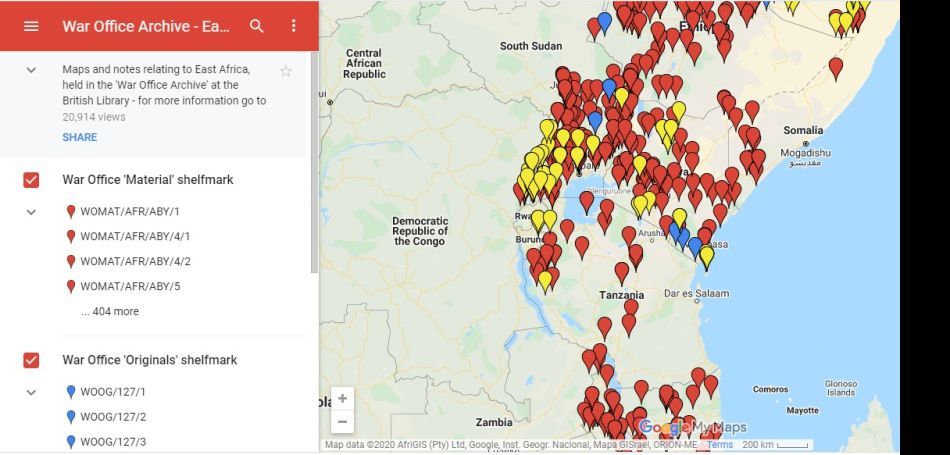How Digital Mapping Can Shape Your Research

Share this step
We have discussed how researchers use maps of the past to reveal rich detail about peoples, societies and groups. Digital mapping tools can also be a powerful way to explore spatial data across a range of different sources. They can also be used in innovative ways to communicate research. In this article, Gethin Rees, Lead Curator for Digital Mapping at the British Library, introduces some of the key concepts and useful tools that you can use in your research.
A map is an attempt to communicate geographical relationships to a viewer. By bringing geographical concepts to the fore, mapping can push research in new directions, generating hypotheses or results that would not be possible otherwise. The shift from the use of print or paper maps to digital maps from the late twentieth century onwards has had a profound impact on research practice in the sciences, social sciences and humanities. This essay introduces this shift with reference to three common research tasks: creating, visualising and analysing geospatial data.
Creating geospatial data
All manner of research sources, texts and datasets contain geographical information, such as place names, postcodes and addresses. However, it is not possible to create a digital map or perform analysis with this geographical information alone. A transformation into geospatial data is necessary. This transformation substitutes the words that constitute geographical information with numbers within a coordinate system to create representative points, lines or polygons. For example, a historical source might state that an event occurred in London. In order to represent this event on a digital map, coordinates that represent London are required. If our map was global in scale we might use a single point to represent the city. On the other hand, if the map depicted the south-east of England only, a point would be misleading and the boundaries of London should be drawn using many points joined to create a polygon. Despite the scientific appearance of such geospatial data, any transformation to coordinates is highly subjective and the result of researcher decisions. If we asked everyone on this course to draw the boundaries of London on a map we would have hundreds of different answers.
Geospatial data has been available for decades on the web and innumerable examples can be downloaded. However, it is not always possible to find a dataset that fits one’s own area of interest and, in many cases, it will be necessary to create geospatial data. In the past, this task was laborious, relying on visits to locations and use of the Global Positioning System. Today, the web offers many easy-to-use tools that expedite the process. For example, a right-click on Google maps provides access to ‘What’s here’ information including the coordinates of the clicked location. Collating this information in a spreadsheet offers a simple way to build a geospatial dataset.
Many humanities researchers work with text, and there are several handy tools available to transform this text into coordinates. A process known as geocoding associates coordinates to place names. This relies on the existence of a gazetteer, a list of place names with coordinates. For example, it is possible to lookup coordinates for London in the online Gazetteer called GeoNames. The geography of London has changed a great deal over the centuries, and the coordinates in GeoNames apply to the modern geographical concept of Greater London. Although detailed and reliable gazetteers do not exist for many periods or geographical areas, the World Historical Gazetteer project seeks to remedy this problem, offering several sets of coordinates for each place with corresponding dates.
A different, but related, task, geoparsing, extracts place names from a body of prose. A user can copy and paste text from a source and the geoparser highlights place names. Depending on the system, the place names might be returned as a spreadsheet or map in many cases, with coordinates (ie, as geocoded data). Geoparsing tools such as Recogito or the Edinburgh Geoparser are freely available and easy-to-use.
Visualising geospatial data
Visualisation is the logical next step after the creation of geospatial data. By ‘visualisation’, we mean plotting coordinates. This is usually onto some background map imagery, turning a spreadsheet into a visual map. Visualisations are not objective reflections of reality. They are created with a specific purpose in mind, and are tailored to meet the requirements of that purpose. When looking at data presented on a map, think about what has been left out. What choices have been made in the depiction of data? Digital maps are no different in this regard to the paper maps discussed elsewhere this week. Visualisation on digital maps has two purposes for the researcher: discovery and research.
Where geospatial data contains URLs, digital web maps afford an innovative method of presentation. A web map offers a gateway through which users can discover interesting links in a dataset. The user is presented with a geographical overview based on locations taken from the data, transformed to coordinates and presented as a pin on a map like Google, Bing or Open Street Map. By clicking on this pin, the user can access a link to their item of choice. Tools such as Google MyMaps package up this functionality and can be embedded in a blog or web page for use by the public. A good example is the British Library’s War Office archive for East Africa which makes it easier to find a map of interest than through a text search.
Researchers can use digital maps to provide new perspectives on a dataset, sparking new questions and interpretations. Visualisation in time and space may highlight geographical patterns, trends or narratives that would not otherwise be apparent from text-based scholarship. Researchers have traditionally used Geographical Information Systems, or GIS, as a tool for visualisation. GIS has a high degree of flexibility, allowing layers to be turned off and on, export of maps for publication, as well as tools for analysis. However, the software requires some expertise and, in many cases, training to use. Therefore, a growing range of web tools have been developed to make visualisation for research easier. A tool like Palladio allows the researcher to upload a spreadsheet of geospatial data, visualise the data on a map, filter by time series, and gain new insights into their area of study. Through this manipulation of data, the user can understand geographical patterns and gain insights as well as creating maps for print publication.
Analysing geospatial data
Analysis is hypothesis-driven or exploratory work that involves the processing of geospatial data to create a new output that generates insights, interpretations or answers a research question. GIS is a commonly-used tool for geospatial analysis, providing statistical methods for quantitative data from the social sciences and sciences. These methods are based on the analysis of numbers: coordinates and quantitative measures. However, humanities researchers are more interested in place, the cultural meanings people attach to a specific location. Indeed, the collections of the British Library are not full of coordinates or numbers, they would not be readable. In recent years, the repurposing of old tools and the creation of new methods have sought to build bridges between the qualitative, interpretive analysis of the humanities and the quantitative tradition of geospatial data analysis.
Techniques including network analysis and natural language processing have opened up datasets like social media or OCR (optical character recognition) text to geospatial analysis. For example, work at the History department, Lancaster University, has examined a large corpus of Lake District writing. The researchers have explored the use of the word sublime and the types of place names it describes. The repurposing of GIS methods demonstrate that sublime is associated with locations at a higher elevation more often than would be expected given the background geography of the corpus. Researchers use this work to provide a better understanding of the sublime and its relationship to mountaineering and tourism in the western part of the lakes. Find out more here.
In this article, Gethin has described the methods for creating geospatial data and how the visualisation and analysis of geospatial data can provide research insights. Have you used geospatial data, either to discover sources or to present your own work using a map? Have you tried using any of the tools described in this article? How might the use of geospatial data, and the tools described here, support your work?
Share this
Learning from the Past: A Guide for the Curious Researcher

Learning from the Past: A Guide for the Curious Researcher


Reach your personal and professional goals
Unlock access to hundreds of expert online courses and degrees from top universities and educators to gain accredited qualifications and professional CV-building certificates.
Join over 18 million learners to launch, switch or build upon your career, all at your own pace, across a wide range of topic areas.
Register to receive updates
-
Create an account to receive our newsletter, course recommendations and promotions.
Register for free







